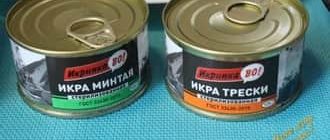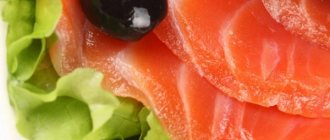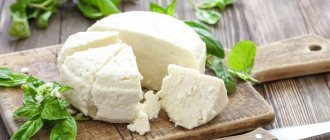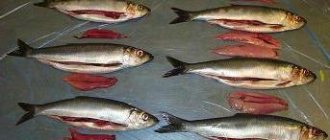Belonging to the salmon family, trout is considered one of the most exquisite varieties of fish. Known for its excellent taste, as well as beneficial properties, it, unfortunately, rarely appears on the tables of ordinary citizens due to its very high price. Nowadays it is mainly bought only on holidays as a delicacy, but despite this, in reality, trout is excellent for the everyday diet. This article will talk about the benefits and harms of trout for the human body.
Features of trout
Before talking about the benefits and harms of trout, you should find out what this fish is. As mentioned earlier, it belongs to the salmon family, which includes a wide variety of species. However, they all have one common feature - they can only live in clean and cold waters, and therefore the quality of trout is usually very high.
In appearance, trout is a fish with an elongated body that is slightly compressed at the sides. Its scales are usually very small and slightly shiny. Its color depends on the color of the water in which the trout lives. Depending on the species, it can have a different size, although its standard weight does not exceed 1 kg and its length is 50 cm. Male trout are usually larger than females and also have a larger head.
What types of trout are there?
In Russia, trout lives in seas, rivers, lakes and large streams. And each of them has its own characteristics.
River trout
The most common river trout species in Russia are Karelian, Rucheevaya and Rainbow.
- Karelian trout can also be found under the name “lake”. It is found in the cold waters of the Karelian and Kola Peninsulas at a depth of up to 100 meters.
- Brook trout or the freshwater variety of brown trout lead a sedentary lifestyle. Lives in streams of the Kola Peninsula, basins of the Caspian, Black, Azov and White seas. Fish of this species are quite large and can grow up to two kilograms.
- Rainbow trout is the most popular species in Russia. Distributed mainly in the rivers of Kamchatka and in reservoirs on the mainland coast of the Sea of Okhotsk and on the Commander Islands.
However, these trout species ( namely wild, not aquaculture ) are not available on an industrial scale. They can only be found in places where they are caught in limited quantities.
Lake trout and freshwater aquaculture
Trout can also be found in lakes or in specialized cages, so-called freshwater aquaculture.
sea trout
Sea trout is a leader in its qualities: it is not as small as river trout, and does not give off the mud, as happens with lake trout, and is superior in the content of useful microelements: iodine, fluorine, manganese and others, as well as fatty acids. You can distinguish it from its freshwater relatives by its richer red color, and therefore the taste of the meat. Sea trout began to be served as a delicacy back in the Middle Ages in France, and then only several centuries later a special technology for breeding this fish appeared in Canada.
There are the following types and subspecies of sea trout: marbled trout, mykiss, silver trout, golden trout, Turkish trout and others. Pacific trout is considered the largest. It can reach a length of 1 meter.
Sea trout are found almost all over the globe, in places where there are suitable bodies of water. FISH2O offers trout that is grown in the environmentally friendly waters of the Barents Sea near the Kola Peninsula. The fish is in a natural environment and eats natural food; it is limited territorially, but is not constrained in its movements and can move freely, which usually does not happen in freshwater aquacultures.
Energy value
Almost all the health benefits and harms of trout depend on its nutritional value. The large amount of omega-3 fatty acids, vitamins, microelements and amino acids it contains gives the fish an incredibly refined taste, and also helps provide the human body with all the beneficial substances it needs.
In addition, this fish has a relatively low calorie content - only 88 kcal per 100 grams, so even those who want to lose weight or adhere to a healthy diet can safely consume it.
Chemical composition, calorie content
Trout has a healing effect on humans.
Compound:
- omega-3 and omega-6 fatty acids;
- lysine;
- leucine;
- alanine;
- valine;
- aspartic and glutamic acids;
- phenylalanine;
- arginine;
- histidine
Content of vitamins, micro and macroelements
| Vitamins | mg per 100 g | Micro and macroelements | mg per 100 g |
| A | 0,02 | Potassium | 417–481 |
| IN 1 | 0,12 | Sodium | 39–75 |
| AT 2 | 0,11 | Phosphorus | 244–271 |
| RR | 5,38 | Magnesium | 28–31 |
| AT 5 | 0,93 | Calcium | 67 |
| AT 6 | 0,04 | Zinc | 1,08 |
| AT 9 | 0,012 | Iron | 0,7 |
| AT 12 | 0,004 | Manganese | 0,160 |
| WITH | 2,4 | Selenium | 0,126 |
| D | 0,033 | Copper | 0,11 |
| E | 2,7 |
The average calorie content of fresh trout is 89–97 kcal, depending on the habitat and nutrition of the fish. Concentration of fats - 7%, proteins - 21%, no carbohydrates. The calorie content of the product varies depending on the cooking method.
| Cooking method | Kcal per 100 g |
| Cooking | 107 |
| For a couple | 117 |
| Baking | 103 |
| Frying with oil | 210 |
| Salting | 186 |
| Smoking | 133 |
| Drying | 382 |
| Liver | 198 |
| Caviar | 233 |
Selection of fish
Trout is a fairly expensive fish, and therefore it is very important when going to the store to choose the highest quality and freshest product in order to get a large amount of useful substances. When purchasing, be sure to pay attention to:
- The color and elasticity of the skin, as well as the overall presentation. Slippery and elastic skin indicates the freshness of the fish. However, if the fish looks unnaturally bright, this may indicate that the sellers specially processed it.
- Cloudiness in the eyes - its presence hints that the fish has been lying there for a long time.
- The color of the gills should be pinkish; if they are dark brown, it means the fish is not fresh.
Something about cooking trout
This type of salmon is used in dietary and other nutrition. If possible, use chilled rather than frozen fish. Red fish dishes are available in almost all cuisines of the world. Most often it is baked, but also boiled and fried. This product is very fatty, which makes grilled dishes especially tasty. Lemon, ginger, and herbs go well with trout.
When preparing oriental dishes, red meat is one of the ingredients for making rolls, sushi, as well as various stews and soups. In the Caucasus it is served with pomegranate sauce. In America, it is customary to thoroughly fry this product, but in Japan, trout is not cooked for long and is eaten almost raw. In European countries, before cooking, red fish meat is marinated in spices and then grilled or barbecued.
Salted fish is often consumed with strong alcoholic drinks, and smoked fish is often consumed with wine and beer.
Beneficial features
When considering the benefits and harms of trout for the body, the first thing to mention is its beneficial qualities. This fish should definitely be included in the diet, if only because the amount of nutrients it contains can almost completely provide the daily requirement for the human body.
In addition, constant consumption of this fish improves brain function and increases activity, helping to quickly cope with any signs of fatigue and drowsiness.
Omega-3 fatty acids, which are found in large quantities in trout, also have a positive effect on the functioning of the brain, as well as the central nervous system, suppressing signs of depression and stress. This substance also helps remove bad cholesterol from the blood and improve the functioning of the cardiovascular system, which is useful for preventing a heart attack or the development of other diseases.
The beneficial properties of trout also include the prevention of many dangerous diseases. It was found that people who regularly consume this fish have a lower risk of developing cancer, atherosclerosis, high blood pressure, diabetes and depression.
As mentioned earlier, trout is also a low-calorie product, and therefore can be consumed even by those who are careful about the amount of calories they consume. In addition, it is quickly digested in the stomach, and therefore beneficial substances quickly enter the bloodstream. It can be consumed even by children and allergy sufferers, since this fish is a hypoallergenic variety.
Cooking features
During cooking, trout does not give off a strong odor and goes well with many foods. The taste of fish is emphasized by lemon, ginger, rosemary, and basil.
Helpful Tips:
- the fillet is cooked quickly - 15–20 minutes;
- trout should be fried in a frying pan with a small amount of oil, it contains its own fat;
- the fish will become juicier if it is wrapped in foil when baking;
- the carcass can be cooked on the grill or grill, it does not fall apart;
- The gills of whole fish should be removed; they impart bitterness to the food.
What products does it combine with?
When creating culinary dishes from trout, keep in mind that not all products can be placed in one plate. This is caused by the following:
- Food differs in terms of digestion time. If you simultaneously consume quickly and slowly digestible foods, the processes of rotting and gas formation are activated.
- The combination of several protein components creates a load on the digestive tract, the stomach cannot cope with food, and the metabolic rate decreases.
- Ingredients in some foods may interfere with the absorption of nutrients from others.
Compatibility table with other products
| Fine | Ghee, whey, greens, cabbage, carrots, beets, pickles, green vegetables |
| Acceptable | Rice, buckwheat, lemon, quinoa, tomatoes, butter, vegetable oil, pumpkin, eggplant, zucchini |
| Badly | Meat, poultry, eggs, mushrooms, cream, sour cream, lard, nuts, seeds, potatoes, dairy products, cheeses, feta cheese, wheat, rye, oats, bread, peas, chickpeas, mung beans, beans, beans, lentils, |
How to quickly clean
Cleaning and gutting a trout carcass is easy:
- Wash fresh fish. Place on a straight surface.
- We make cuts under the upper fins and remove the head.
- Using sharp scissors, cut off all remaining fins.
- Remove the scales. To do this, run the smallest side of a vegetable grater several times over the trout’s body from tail to head.
- Rinse well with running water.
- Using a sharp knife or scissors, cut the belly of the fish and remove the entrails.
The cleaning process followed by fillet separation is described in more detail in the video.
Is it possible to eat raw trout?
Experts do not recommend eating raw trout. This is due to the fact that under natural conditions fish are often infected with parasites. The danger of artificially grown specimens is that when feeding, antibiotics and dyes are added to the cage. Heat treatment allows you to protect against helminths and partially destroy harmful synthetic impurities. However, culinary experts in many countries consider raw trout edible. For example, in Japan it is added to sushi.
How to pickle at home
There are 2 methods of salting fish: dry and in marinade. For salads, slices and sandwiches we use the first one.
Ingredients:
- 500 g fillet;
- 2 tbsp. l. salt;
- 1 tbsp. l. Sahara;
- ground black pepper.
Preparation:
- Mix salt and sugar in one container.
- Sprinkle the fish with the resulting mixture on both sides.
- Add pepper.
- Place the trout in a container with a lid and put it in the refrigerator.
- After a day, we take out the product and remove the remaining salt with a napkin.
For the marinade, use 1 tablespoon of salt and sugar per 1 liter of water. The quantity depends on the size of the trout. The fish should be kept in the marinade for 48 hours if it is cut into pieces, and up to 3 days if using a whole carcass.
Harmful properties
Trout is not only beneficial, but also harmful to the body, so when introducing it into the diet, all contraindications must be taken into account. First of all, it should be used very carefully during pregnancy and lactation, since fish often contains mercury. And if the proportion of the substance that is in it is tiny for an adult and cannot harm him, then it can affect a child very negatively.
People with ulcers in the gastrointestinal tract and liver disorders should also be very careful about this fish, since the saturated fats it contains increase the level of functioning of the digestive system. It would also be better not to use trout heads when preparing dishes, since it is in them that toxic substances from the reservoirs in which the trout lived accumulate.
Possible harm from eating trout
- A contraindication to excessive use of this product is the presence of chronic diseases of the liver, gastrointestinal tract, and stomach ulcers.
- There are many parasites in river fish, and therefore harm may come from insufficient heat treatment of trout.
- Sometimes this fish may contain mercury, which is dangerous for everyone and especially for pregnant women, because it can cause poisoning of the fetus.
- If there is an excess of retinol contained in this product, poisoning of the body may occur. With such intoxication, the following are possible: nausea, liver enlargement, headache and other symptoms.
- It is not recommended to eat this fish if you are allergic.
- If the sea trout is sea trout, then you should not cook it with the head; it may contain harmful substances that have accumulated in the water where the fish lived.
sea trout
Now let's talk directly about the benefits and harms of sea trout, as well as its differences from all other varieties. Such fish are considered the most valuable catch for fishermen, since they are very difficult to catch. Its meat is redder in color than all other varieties. Females are usually larger than males, and the fish itself may be larger than its relatives from other habitats. In size it can reach from 50 cm to 1 m, and in weight individuals up to 25 kg have been found, although they rarely actually grow that large.
The meat of this type of trout is fattier and tastier than other varieties, it contains a large amount of vitamins and amino acids, and is also higher in calories. Its frequent use has a positive effect on metabolism, lowers cholesterol, and also helps fight depression and improves memory. It is often recommended for restoring protein and fat metabolism, as well as preventing cancer.
This is interesting!
Why is rainbow trout called that?
The trout's body shape is remarkably adapted to the conditions in which it lives: be it a strong current or other environmental factors. The color of the fish can be adjusted to the color of the soil and waters in which the fish is currently located. The rainbow trout got its name thanks to the crimson-red stripe along the lateral line; this color shimmers with all the colors of the rainbow; a special name was chosen for it: salmon pink.
Fish – “meteor”
Trout can be called a real “fast” fish, since it can reach speeds of up to sixteen kilometers per hour, while the rest of its relatives only reach eight. Sometimes, escaping from pursuers, fish reach such speeds that they literally jump out of the water to a height of up to two meters.
Trout can be called a universal fish: it is smoked, salted, boiled, fried, combined with various side dishes and served with lemon and herbs. In Italian cuisine, trout is served with pasta, and in France - with rice and vegetables. It goes well with other types of fish and is very tasty as an independent dish. So those who call trout the “queen” of fish are absolutely right.
You can find more recipes with wonderful trout on our Instagram
Rainbow trout
One of the most common species that is actively targeted by anglers is the rainbow trout. The benefits and harms of this species, which lives in ponds and lakes, are practically no different from all other varieties. Its standard dimensions are 40-50 cm in length, and its weight is about two kilograms. A special feature is the light shades of the scales, which are almost invisible on the bottom of the lake, which has led to the fact that this fish is often called white trout.
The meat of rainbow trout is light pink, and it is much less fatty than that of sea fish. In addition, it is much less expensive, and therefore can be prepared more often without causing much harm to the wallet.
Now let's talk directly about the benefits and harms of trout fish. Its calorie content is slightly higher - 119 kcal per 100 grams, but it is still a low-calorie product that is suitable for adherents of a healthy diet and people losing weight. It contains a large amount of protein, omega-3, as well as vitamins A, E and D, which are very useful for people’s lives, especially for those who lead an active lifestyle. Also, by regularly eating rainbow trout, you can easily compensate for the lack of potassium, magnesium, phosphorus, zinc, iron and sodium in the body.
Surprisingly, rainbow trout has only one contraindication - an allergic reaction, so if it does not exist, then you can eat this fish for your pleasure without any harm - although this must be done in normal quantities.
History of trout
It is believed that trout were exported to Europe from America in 1880, where they became widely popular in fish farms. And indeed, according to the opinion of the participants, Gen. Assembly in 2005, the homeland of wild trout is considered to be the zone of the Southern Appalachian Plateau, in the northern part of the Carolinas, in the USA. This opinion was formed due to studies of the genetic material of fish.
The history of trout in Russia began in 1890, where it came from Germany.
Today, rainbow trout is bred in many countries of the world: Norway, Denmark, Italy, France, Russia.
River trout
Now let's move on to finding out the benefits and harms of river trout. It lives in streams and rivers located in mountainous areas, since this is where the waters are the cleanest. It is this variety that is considered the most valuable, since the meat of this fish is clean and very nutritious, and also has a delicate flavor.
It is small in size - the usual size of wild individuals is about 35 cm, and its weight is no more than half a kilogram. The color of its meat is usually pinkish.
Now we will directly consider the benefits and harms of trout of this species. First of all, fish is considered a valuable source of animal protein, which is very well absorbed by the body. The huge amount of amino acids contained in it helps improve protein metabolism, and also affects the functioning of the cardiovascular system and helps cope with anemia. Quite often, river trout is recommended for consumption by people who suffer from severe and long-term illnesses to replenish their strength.
The role of unsaturated fatty acids, which are found in large quantities in trout, cannot be underestimated. They prevent the development of atherosclerosis, and also help cope with ischemia, heart attacks and strokes, and often even prevent them.
Smoked, smoked, dried trout
Trout is very tasty when dried, smoked or dried. The products have pros and cons:
- Smoked fish. Prepared cold and hot. Both types of processing produce a delicate, moderately fatty product with a pleasant aroma. When smoked, fish retains most of the vitamins and minerals and unsaturated fatty acids. But the effects of many beneficial substances are neutralized by carcinogens formed during cooking. They activate the development of cancer cells, worsen the condition of the liver, and provoke congestion in the bile ducts.
- Dried. It is salted and dried. The result is a soft fish that goes well with potatoes and other side dishes. Due to the lack of heat treatment, the product does not lose vitamins and microelements. But such trout is dangerous for hypertensive patients, people with vascular and kidney problems. Due to fluid retention in the body, pressure rises, swelling forms, and toxins accumulate.
- Dried fish. Cooking is similar to drying, but the carcasses take longer to dry and they lose almost all the liquid. The peculiarity of this type of fish is that even with prolonged weathering it does not become as hard as ram. Dried trout is tasty, slightly oily. It contains many useful substances. But due to the loss of liquid, such fish is 3.5 times more nutritious than boiled fish, and 2 times the calorie content of lightly salted trout. The downside is also the salt concentration. The dry product provokes swelling, problems with the heart, blood vessels and kidneys.
The benefits and harms of farmed trout
Due to the modern environmental situation, as well as the needs of humanity for fish products, fish are increasingly being grown in artificial reservoirs. However, it is worth understanding that the benefits and harms of trout produced in this way differ significantly from its wild counterparts.
Unfortunately, now in this area various hormones, antibiotics, food additives, preservatives and dyes are actively used, that is, various chemicals that negatively affect the taste and benefits. For example, to give color to meat, the dye canthaxanthin is added to the feed, which negatively affects human vision and also destroys the iris of the eye. Hormonal stimulants, which are also very popular, accelerate the growth of fish, making it larger, but at the same time its meat is much softer and fattier, which is also harmful to humans.
It is impossible not to mention parasites. Since farmed trout live in closed conditions, and in quite cramped ones, often the disease of one individual can lead to the disease of the entire stock. This is why fish are actively fed with antibiotics to prevent financial losses. All this has led to the fact that meat contains such a large number of carcinogens that they only increase the risk of developing cancer, rather than preventing it.
How and how long can trout be stored?
Trout is a perishable product. A simple tip is to store seafood in the refrigerator. The benefits and properties are significantly lost when the product is re-frozen. Due to technology violations, bacteria may appear.
Worth knowing:
- for a chilled carcass in the refrigerator, it is better to use crushed ice;
- to extend the shelf life, the fish is lubricated with vegetable oil, washed and dried before cooking;
- when a light coating appears, it is cut off, and the carcass is quickly used for food;
- seafood can be stored in the freezer; it is wrapped in parchment, which will protect the carcass from excess moisture and preserve its beneficial properties;
- Do not place the product next to milk or sausage;
- The fish will last longer if you keep it in salt water before putting it in the refrigerator.
Important! Partial defrosting of the carcass should not be allowed. If conditions are violated, fish can cause harm to the body.
If you do not plan to cook the fish within 3 days, then it is better to put it in the freezer. Salted or marinated fish will keep in the refrigerator for 7-10 days. You cannot create sudden changes in temperature - the beneficial properties of the product will be disrupted.
The benefits and harms of lightly salted trout
Trout meat, like its caviar, is now considered one of the most delicious delicacies. Basically, it is served lightly salted, since in this form you can feel all the nuances of taste. It should be noted that in this form this product has the same great benefits as if it were boiled or steamed. Of course, its calorie content will be much higher - 229 kcal per 100 grams, but lightly salted trout is usually consumed in small quantities as an appetizer or canapé.
Lightly salted trout contains a large amount of useful vitamins and minerals, and therefore it is often recommended for people with melancholy or depression, since its regular inclusion in the diet helps cope with bad mood. It also helps remove harmful toxins from the body and helps fight intestinal diseases.
If we consider the benefits and harms of lightly salted trout, we cannot fail to mention phosphorus, which has a positive effect on the body, improving the functioning of the brain and circulatory system. However, it is worth mentioning the most important disadvantage of this product - it should not be eaten by hypertensive patients, since the salt contained in the dish can easily raise blood pressure, which will negatively affect well-being.
Is it possible for children
Salmon is good for children. They provide the developing body with a supply of essential vitamins and minerals. Fish protein is absorbed faster and creates less stress on the digestive system than animal protein.
You should start feeding your child trout from the age of 3. Before this age, he may develop allergies, complicated by Quincke's edema.
Rules for introducing fish into the children's menu:
- 1st time - a piece equal to a teaspoon;
- if no signs of allergy appear within 24 hours, increase the single dose to 30 g;
- gradually increase the portion to 60–70 g;
- cook, bake, steam the product.
Salted trout: is it healthy?
The benefits and harms of salted trout also cannot be underestimated. With the help of this product you can significantly influence the functioning of the most important systems in the human body. Omega-3 fatty acids help maintain normal cholesterol levels in the blood and also affect the condition of the circulatory and nervous systems. Surprisingly, in salted trout you can find 8 amino acids, which doctors consider necessary for a person to lead a normal life. A huge amount of protein is also necessary to maintain health, and together with fats, vitamins and other beneficial substances, this product is often indispensable on the tables of athletes.
Among the harmful qualities, it is worth mentioning that such fish should not be consumed by people with diseases of the liver and gastrointestinal tract, since fats and salt can harm them.
Why should you take Omega 3?
Why do women take omega-3? Of course, both for beauty and health. And women’s health especially urgently needs omega-3 polyunsaturated fatty acids during such a critical period for a woman as menopause. The menopausal period is characterized by a decrease in the level of female sex hormones estrogen. This leads to the development of atrophic changes in the tissues of the woman’s cardiovascular and nervous system.
In this case, the physiological mechanisms that ensure the stability and tone of blood vessels are disrupted, hemodynamics are subject to changes, and the risk of blood clots increases several times. Due to their antithrombotic, antiatherosclerotic and neuroprotective properties, omega-3 PUFAs can stop the development of cardiovascular diseases, as well as vasomotor and emotional-mental disorders during perimenopause and menopause.
Estrogen deficiency during menopause causes rapid aging of the skin, the youth and elasticity of which have been maintained for many years thanks to the action of female hormones. From the age of 25, the content of collagen, which is responsible for the density and elasticity of the skin, decreases by 1% annually. And with the onset of menopause, its amount decreases by 30% over 5 years!
Thanks to their unique properties, omega-3 acids can slow down the aging process of the skin.
The beneficial properties of omega 3 during estrogen deficiency during menopause are undeniable. The substance rapidly accelerates the development of osteoporosis, which reduces bone strength and increases the risk of fractures. To some extent, omega-3 PUFAs help increase bone density, having a positive effect on calcium metabolism and collagen production in the body.
Omega-3 during pregnancy
Polyunsaturated acids are especially important during the period of intrauterine development of the baby. They contribute to the formation of the baby's nervous system and brain. Every day, the mother's body transfers 2 grams of Omega-3 to the child.
To normalize the balance of fats, you should take capsules with them, especially they help with toxicosis, when getting the right amount of vitamins is problematic.
In winter, everyone experiences a lack of Omega-3, but in pregnant women it can cause depression.
Benefits for the Heart
Omega-3 includes two fatty acids:
- docosahexaenoic acid (DHA);
- eicosapentaenoic acid (EPA).
Their action is aimed at reducing the amount of lipids in the blood. They have anti-inflammatory and antiarrhythmic properties. Dilate blood vessels and thin the blood
, thereby normalizing blood flow and preventing the formation of blood clots. These acids strengthen the walls of blood vessels and prevent damage caused by stress hormones. By consuming Omega-3, you can reduce the risk of coronary heart disease and myocardial infarction.
The benefits of Omega-3 for the cardiac system are so great that in some cases it can protect a person from coronary death.
Benefits for the musculoskeletal system
Omega-3 or fish oil has a triple effect on bones and joints:
- at a young age it actively participates in the process of bone formation, and at an old age it prevents the destruction of bone tissue, maintains the elasticity of the connecting elements of joints, and improves lubrication properties;
- reduces the intensity of inflammatory processes in the joints, eliminates pain;
- slows down the breakdown of collagen fibers of cartilage in various diseases.
Omega-3 consumption reduces the occurrence of joint diseases by 50%. It is prescribed to drink in combination with painkillers and anti-inflammatory drugs, since fish oil enhances their effect.
When treating arthrosis of the knee joint, Omega-3 prolongs its service life, improves mobility and dulls pain.
Benefits for the brain
As a result of a lack of fish oil, a person may experience earlier aging of the brain and a decrease in his intellectual abilities.
.
Regular consumption of polyunsaturated fats has a beneficial effect on visual memory, the ability to think and solve several problems at the same time. They protect the brain from neurodegeneration, which occurs in many older people. Their deficiency causes Alzheimer's disease, multiple sclerosis, poor vision, lack of concentration, aggression and violence, including suicidal behavior. Little girls become irritable, inattentive, and lack understanding when mastering educational materials; they find it difficult to learn to read.
Benefits for anxiety
Mental disorders today are not uncommon phenomena; the accelerated development of new technologies and rapid changes in lifestyles lead to confusion and self-doubt, and this results in depression and constant anxiety. Omega-3 acts as an antidepressant
, bringing a person’s condition back to normal when taken correctly and regularly. After it, a person’s sleep normalizes due to a decrease in the concentration of melatonin, the sleep hormone, in the brain.
Benefits for the skin
Fish oil has a beneficial effect on the skin, affecting it comprehensively:
- fights chronic inflammation
, and thereby prevents the destruction of collagen, which is responsible for youthful skin; - improves the resistance of the skin
to external influences, reduces their sensitivity; - having antioxidant properties
, prevents oxygen from harming the skin; - stops the progression of inflammation
of internal organs, which affects the condition of the skin; - increases skin resistance to ultraviolet radiation
; - maintains the elasticity
of the collagen base, and thereby prolongs the youth of the skin; - inhibits aging mechanisms
throughout the body.
Many successful top models regularly drink Omega-3 capsules for prevention.
Benefits for hair
Healthy fats accelerate the growth of curls, stimulate the hair follicles, which for various reasons were in a dormant state, strengthen them and make the locks beautiful. Omega-3 is often taken by those who want to get rid of chronic hair loss. Lovers of multiple styles need not worry about the condition of their curls, since this product will provide them with reliable protection from thermal and mechanical damage.











